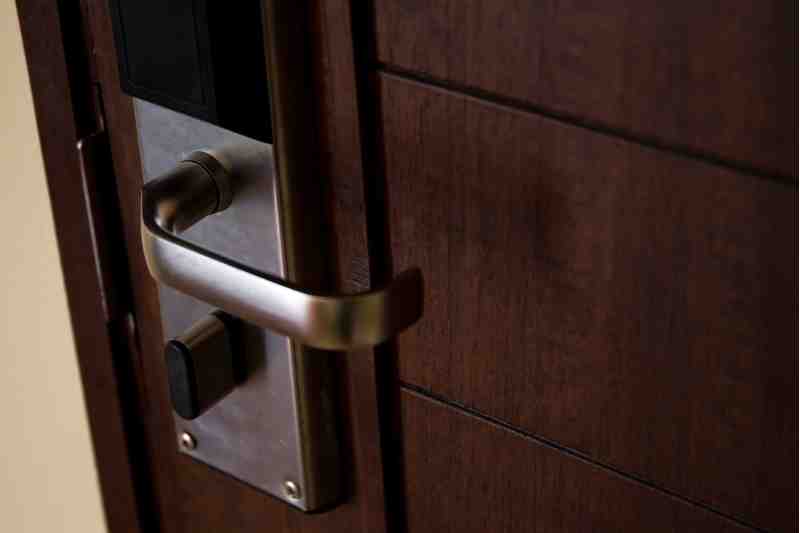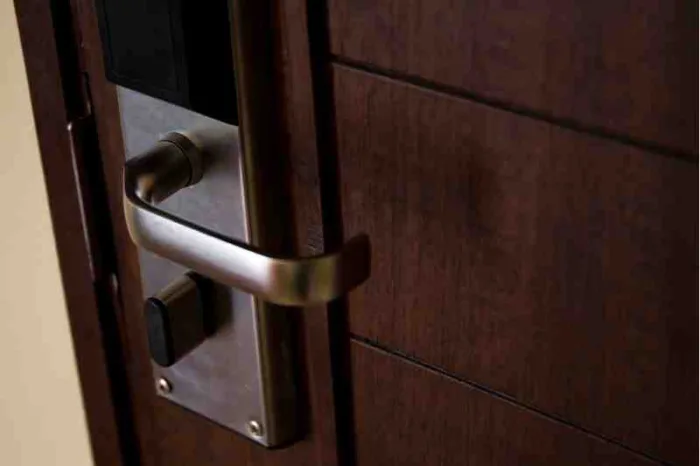Key takeaways
- Fail-safe locks require power at all times to stay locked; If the power goes out, they automatically unlock.
- Fail-secure locks stay locked without power but need power to be unlocked.
- The primary difference between fail-safe vs. fail-secure locks is their response to power outages.
- You should use fail-safe locks in areas where safety is a priority, such as lobbies, main entryways, and stairwells. Meanwhile, fail-secure locks are best suited for rooms where security is essential, such as sensitive storage areas or IT servers.

If you’re installing new electric locks to secure your property, you have a lot of options to choose from. However, you have two main categories of electric locks: fail-safe and fail-secure. But what is a fail-safe or fail-secure lock? Further, what’s the difference between the two, and how does that affect you, your employees, and your commercial or apartment tenants?
In this post, we compare fail-safe vs. fail-secure locks and their relations to apartment intercom systems with door releases. Then, we explain which type of lock you should use to secure different areas of your property before telling you why including these locks with an access control system is essential.
This post covers:
- What is a fail-safe lock?
- What is a fail-secure lock?
- Difference between fail-safe and fail-secure locks
- When to use fail-safe vs. fail-secure locks?
- Create a unified access control system
Learn about the differences between electric locks and magnetic locks:
What is a fail-safe lock?
Fail-safe locks are electronic locks that require a continuous power supply to stay locked. When power is disrupted — whether intentionally by a valid access credential or unintentionally during a power outage — the lock disengages.
This characteristic ensures that building occupants can freely exit in an emergency, prioritizing human safety over security — hence the term “fail-safe.”
A good example of a fail-safe lock is a magnetic lock. Often referred to as maglocks, magnetic locks hold the door securely shut when powered. However, if the power is cut, the magnet disengages and the door can be pushed open.
What is a fail-secure lock?
Fail-secure locks operate on the opposite principle. These locks remain locked when there is a loss of power, ensuring that secured areas stay protected even during a power outage.
However, it is important to note that in most cases, these locks still allow for egress from the inside, ensuring that occupants can exit the secured area if necessary. The locks are commonly used alongside access control systems, which allow users to override the lock in an emergency.
Difference between fail-safe vs. fail-secure locks
The primary difference between fail-safe vs. fail secure locks is their response to power outages. Fail-safe locks unlock when power is lost, while fail-secure locks remain locked.
As such, this distinction makes fail-safe locks better suited for areas where the safety of building occupants is the top priority, ensuring that everyone can exit quickly and safely in an emergency.
On the other hand, fail-secure locks are ideal for securing valuable assets or sensitive information, as they maintain security even when the power is down.
The choice between fail-safe and fail-secure locks should be based on the specific needs of each area within your property. For example, a building’s main entrance will benefit from a fail-safe lock to ensure people can exit during a power outage, while a storage area within the same building requires a fail-secure lock to protect sensitive equipment and information.
Overall, here is how fail-safe vs. fail-secure locks compare:
When to use fail-safe vs. fail-secure locks?
Deciding when to use fail-safe or fail-secure locks depends on the specific security and safety requirements of different areas within your building.
Use fail-safe locks when:
- Safety is the priority. Areas where a quick and easy exit is critical during an emergency, such as main entrances, stairwells, or emergency exits, should use fail-safe locks. That way, people can leave the building without being hindered during an emergency.
- There is high foot traffic. In spaces with constant movement, like lobbies or public access areas, fail-safe locks provide a practical solution by allowing free exit in case of a power failure.
- Meeting building code compliance. In many jurisdictions, building codes require certain exits, particularly those used as emergency egress routes, to be equipped with fail-safe locks to ensure occupant safety.
You should use fail-secure locks when:
- Security is the priority. Areas that require strict control over access, such as IT server rooms, sensitive storage areas, or any space where valuable assets are stored, should use fail-secure locks. These locks ensure that these areas remain secure even during power outages.
- Considering fire safety. Certain doors, like fire-rated doors, are required by building codes to remain closed during a fire to prevent the spread of flames and smoke. So, fail-secure locks are often used in these areas to combat fires.
- Controlling access to specific areas. In facilities with restricted areas that only authorized personnel should enter, fail-secure locks provide the necessary security by maintaining a locked state during power interruptions.
Create a unified access control system
Using fail-safe and fail-secure locks alongside an access control system creates a unified security solution that meets your safety and security needs. A well-designed access control system can manage who has access to different areas of your building while providing a detailed log of who is entering and exiting your property.
For that reason, you should consider ButterflyMX as your preferred access control platform. ButterflyMX is a cloud-based access control company that has been installed in more than 15,000 buildings and has received over 40,000 five-star reviews.
Our Access Control System offers a property-wide solution, meaning you can manage all entryways and areas, from the front door and gate to elevators, garages, and individual apartments. Use the ButterflyMX OS to manage access permissions, review audit logs, and grant access to visitors remotely from your phone or desktop.
ButterflyMX Access Control offers the following advantages:
- Multiple credentials. Choose between our mobile app, key cards, fobs, and PIN codes to use the credentials that offer the most convenience and security for your property.
- Integrations. Integrate ButterflyMX Access Control with all of our other products, as well as many third-party software and hardware for a centralized management experience.
- Remote management. Manage one or multiple properties from the ButterflyMX OS through a desktop or our mobile app without ever stepping foot onsite.
- Audit log. Review a detailed date- and time-stamped log of entry events to gain more insights into how your property operates and to resolve potential security issues better.
- Mobile app. Enable tenants and employees to grant their visitors, delivery drivers, and service workers remote access through the ButterflyMX mobile app, offering a better experience for both parties.






